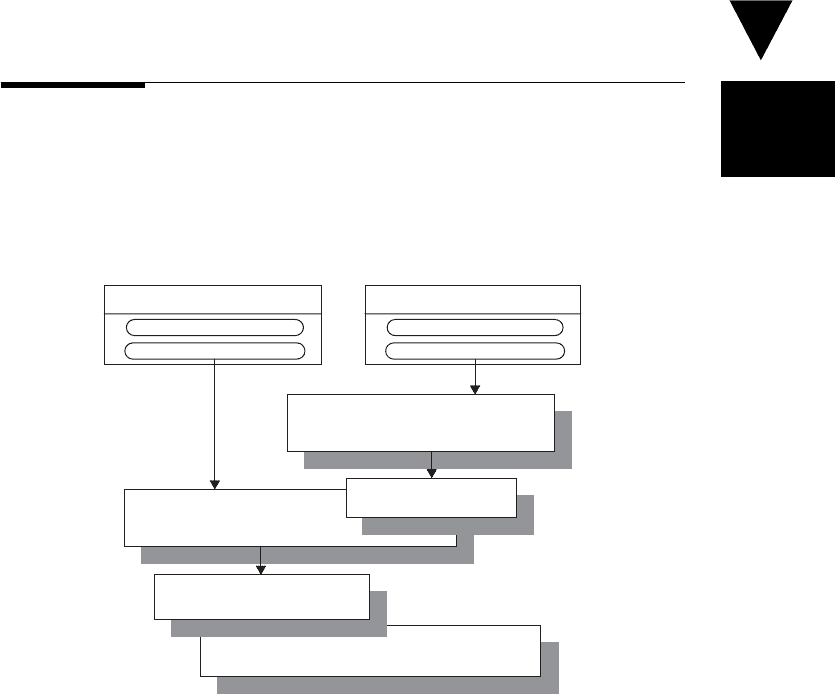Meszaros G. xUnit Test Patterns Refactoring Test Code
Подождите немного. Документ загружается.


the post-test state of the SUT via a back door to compare it with expected
outcome. For customer tests, the back door is most commonly a test database,
but it could also be some other component on which the SUT depends, including
a Registry [PEAA] object or even the fi le system. For unit tests, the back
door is some other class or object or an alternative interface of the SUT (or a
Test-Specifi c Subclass; page 579) that exposes the state in a way “normal” clients
wouldn’t use. We can also replace a depended-on component (DOC) with a
suitably confi gured Test Double (page 522) instead of using the real thing if
that makes the job easier.
When to Use It
We might choose to use Back Door Manipulation for several reasons which we’ll
examine in more detail shortly. A prerequisite for using this technique is that some
sort of back door to the state of the system must exist. The main drawback of
Back Door Manipulation is that our tests—or the Test Utility Methods (page 599)
they call—become much more closely coupled to the design decisions we make
about how to represent the state of the SUT. If we need to change those decisions,
we may encounter Fragile Tests (page 239). We need to decide whether this price
is acceptable on a case-by-case basis. We can greatly reduce the impact of the close
coupling by encapsulating all Back Door Manipulation in Test Utility Methods.
Using Back Door Manipulation can also lead to Obscure Tests (page 186) by
hiding the relationship of the test outcome to the test fi xture. We can avoid this
problem by including the test data being passed to the Back Door Manipulation
mechanism within the Testcase Class (page 373), or at least mitigate it by using
Finder Methods (see Test Utility Method) to refer to the objects in the fi xture
via intent-revealing names.
A common application of Back Door Manipulation involves testing basic
CRUD (Create, Read, Update, Delete) operations on the SUT’s state. In such a
case, we want to verify that the information persisted and can be recovered in the
same form. It is diffi cult to write round-trip tests for “Read” without also testing
“Create”; likewise, it is diffi cult to test “Update” or “Delete” without testing both
“Create” and “Read.” We can certainly test these operations by using round-trip
tests, but this kind of testing won’t detect certain types of systemic problems, such
as putting information into the wrong database column. One solution is to con-
duct layer-crossing tests that use
Back Door Manipulation to set up or verify the
contents of the database directly. For a “Read” test, the test sets up the contents
of the database using Back Door Setup and then asks the SUT to read the data.
For a “Write” test, the test asks the system to write certain objects and then uses
Back Door Verifi cation on the contents of the database.
Back Door
Manipulation
Chapter 18 Test Strategy Patterns
328

Variation: Back Door Setup
One reason for doing Back Door Manipulation is to make tests run faster. If a
system does a lot of processing before putting data into its data store, the time it
takes for a test to set up the fi xture via the SUT’s API could be quite signifi cant.
One way to make the tests run faster is to determine what those data stores
should look like and then create a means to set them up via the back door
rather than through the API. Unfortunately, this technique introduces its own
problem: Because Back Door Setup bypasses enforcement of the object creation
business rules, we may fi nd ourselves creating fi xtures that are not realistic and
possibly even invalid. This problem may creep in over time as the business rules
are modifi ed in response to changing business needs. At the same time, this ap-
proach may allow us to create test scenarios that the SUT will not let us set up
through its API.
When we share a database between our SUT and another application, we
need to verify that we are using the database correctly and that we can handle
all possible data confi gurations the other applications might create. Back Door
Setup is a good way to establish these confi gurations—and it may be the only
way if the SUT either doesn’t write those tables or writes only specifi c (and
valid) data confi gurations. Back Door Setup lets us create those “impossible”
confi gurations easily so we can verify how the SUT behaves in these situations.
Variation: Back Door Verifi cation
Back Door Verifi cation involves sneaking in to do State Verifi cation of the SUT’s
post-exercise state via a back door; it is mostly applicable to customer tests (or
functional tests, as they are sometimes called). The back door is typically an
alternative way to examine the objects in the database, usually through a stan-
dard API such as SQL or via data exports that can then be examined with a fi le
comparison utility program.
As mentioned earlier, Back Door Manipulation can make tests run faster. If
the only way to get at the SUT’s state is to invoke an expensive operation (such
as a complex report) or an operation that further modifi es the SUT’s state, we
may be better off using Back Door Manipulation.
Another reason for doing Back Door Manipulation is that other systems
expect the SUT to store its state in a specifi c way, which they can then access
directly. This is a form of indirect output. In this situation, standard round-trip
tests cannot prove that the SUT’s behavior is correct because they cannot
detect a systematic problem if the “Write” and “Read” operations make the
same mistake, such as putting information into the wrong database column.
The solution is a layer-crossing test that looks at the contents of the database
Back Door Manipulation
Back Door
Manipulation
329

directly to verify that the information is stored correctly. For a “Write” test,
the test asks the system to write certain objects and then inspects the contents
of the database via the back door.
Variation: Back Door Teardown
We can also use Back Door Manipulation to tear down a Fresh Fixture (page 311)
that is stored in a test database. This ability is especially benefi cial if we can use
bulk database commands to wipe clean whole tables, as in Table Truncation
Teardown (page 661) or Transaction Rollback Teardown (page 668).
Implementation Notes
How we implement Back Door Manipulation depends on where the fi xture lives
and how easily we can access the state of the SUT. It also depends on why we
are doing Back Door Manipulation. This section lists the most common imple-
mentations, but feel free to use your imagination and come up with other ways
to use this pattern.
Variation: Database Population Script
When the SUT stores its state in a database that it accesses as it runs, the easiest
way to do Back Door Manipulation is to load data directly into that database
before invoking the SUT. This approach is most commonly required when we
are writing customer tests, but it may also be required for unit tests if the classes
we are testing interact directly with the database. We must fi rst determine the
pre-conditions of the test and, from that information, identify the data that the
test requires for its fi xture. We then defi ne a database script that inserts the cor-
responding records directly into the database bypassing the SUT logic. We use
this Database Population Script whenever we want to set up the test fi xture—a
decision that depends on which test fi xture strategy we have chosen. (See Chap-
ter 6, Test Automation Strategy, for more on that topic.)
When deciding to use a Database Population Script, we will need to maintain
both the Database Population Script and the fi les it takes as input whenever we
modify either the structure of the SUT’s data stores or the semantics of the data
in them. This requirement can increase the maintenance cost of the tests.
Variation: Data Loader
A Data Loader is a special program that loads data into the SUT’s data store.
It differs from a Database Population Script in that the Data Loader is written
in a programming language rather than a database language. This gives us a bit
Back Door
Manipulation
Chapter 18 Test Strategy Patterns
330

more fl exibility and allows us to use the Data Loader even when the system state
is stored somewhere other than a relational database.
If the data store is external to the SUT, such as in a relational database, the
Data Loader can be “just another application” that writes to that data store.
It would use the database in much the same way as the SUT but would get its
inputs from a fi le rather than from wherever the SUT normally gets its inputs
(e.g., other “upstream” programs). When we are using an object relational
mapping (ORM) tool to access the database from our SUT, a simple way to
build the Data Loader is to use the same domain objects and mappings in our
Data Loader. We just create the desired objects in memory and commit the
ORM’s unit of work to save them into the database.
If the SUT stores data in internal data structures (e.g., in memory), the Data
Loader may need to be an interface provided by the SUT itself. The following
characteristics differentiate it from the normal functionality provided by the SUT:
• It is used only by the tests.
• It reads the data from a fi le rather than wherever the SUT normally gets
the data.
• It bypasses a lot of the “edit checks” (input validation) normally done
by the SUT.
The input fi les may be simple fl at fi les containing comma- or tab-delimited text,
or they could be structured using XML. DbUnit is an extension of JUnit that
implements Data Loader for fi xture setup.
Variation: Database Extraction Script
When the SUT stores its state in a database that it accesses as it runs, we can
take advantage of this structure to do Back Door Verifi cation. We simply use a
database script to extract data from the test database and verify that it contains
the right data either by comparing it to previously prepared “extract” fi les or by
ensuring that specifi c queries return the right number of records.
Variation: Data Retriever
A Data Retriever is the analog of a Data Loader that retrieves the state from the
SUT when doing Back Door Verifi cation. Like a trusty dog, it “fetches” the data
so that we can compare it with our expected results within our tests. DbUnit is an
extension of JUnit that implements Data Retriever to support result verifi cation.
Back Door Manipulation
Back Door
Manipulation
331

Variation: Test Double as Back Door
So far, all of the implementation techniques described here have involved inter-
acting with a DOC of the SUT to set up or tear down the fi xture or to verify the
expected outcome. Probably the most common form of Back Door Manipula-
tion involves replacing the DOC with a Test Double. One option is to use a
Fake Object (page 551) that we have preloaded with some data as though the
SUT had already been interacting with it; this strategy allows us to avoid using
the SUT to set up the SUT’s state. The other option is to use some kind of Con-
fi gurable Test Double (page 558), such as a Mock Object (page 544) or a Test
Stub (page 529). Either way, we can completely avoid Obscure Tests by making
the state of the Test Double visible within the Test Method (page 348).
When we want to perform Behavior Verifi cation (page 468) of the calls made
by the SUT to one or more DOCs, we can use a layer-crossing test that replaces
the DOC with a Test Spy (page 538) or a Mock Object. When we want to
verify that the SUT behaves a specifi c way when it receives indirect inputs from
a DOC (or when in some specifi c external state), we can replace the DOC with
a Test Stub.
Motivating Example
The following round-trip test verifi es the basic functionality of removing a fl ight
by interacting with the SUT only via the front door. But it does not verify the
indirect outputs of the SUT—namely, that the SUT is expected to call a logger to
log each time a fl ight is removed along with the day/time when the request was
made and the user ID of the requester. In many systems, this would be an ex-
ample of “layer-crossing behavior”: The logger is part of a generic infrastructure
layer, while the SUT is an application-specifi c behavior.
public void testRemoveFlight() throws Exception {
// setup
FlightDto expectedFlightDto = createARegisteredFlight();
FlightManagementFacade facade = new FlightManagementFacadeImpl();
// exercise
facade.removeFlight(expectedFlightDto.getFlightNumber());
// verify
assertFalse("flight should not exist after being removed",
facade.flightExists( expectedFlightDto.
getFlightNumber()));
}
Back Door
Manipulation
Chapter 18 Test Strategy Patterns
332

Refactoring Notes
We can convert this test to use Back Door Verifi cation by adding result verifi cation
code to access and verify the logger’s state. We can do so either by reading that state
from the logger’s database or by replacing the logger with a Test Spy that saves the
state for easy access by the tests.
Example: Back Door Result Verifi cation Using a Test Spy
Here’s the same test converted to use a Test Spy to access the post-test state of
the logger:
public void testRemoveFlightLogging_recordingTestStub()
throws Exception {
// fixture setup
FlightDto expectedFlightDto = createAnUnregFlight();
FlightManagementFacade facade =
new FlightManagementFacadeImpl();
// Test Double setup
AuditLogSpy logSpy = new AuditLogSpy();
facade.setAuditLog(logSpy);
// exercise
facade.removeFlight(expectedFlightDto.getFlightNumber());
// verify
assertEquals("number of calls", 1,
logSpy.getNumberOfCalls());
assertEquals("action code",
Helper.REMOVE_FLIGHT_ACTION_CODE,
logSpy.getActionCode());
assertEquals("date", helper.getTodaysDateWithoutTime(),
logSpy.getDate());
assertEquals("user", Helper.TEST_USER_NAME,
logSpy.getUser());
assertEquals("detail",
expectedFlightDto.getFlightNumber(),
logSpy.getDetail());
}
This approach would be the better way to verify the logging if the logger’s data-
base contained so many entries that it wasn’t practical to verify the new entries
using Delta Assertions (page 485).
Example: Back Door Fixture Setup
The next example shows how we can set up a fi xture using the database as a
back door to the SUT. The test inserts a record into the EmailSubscription table
and then asks the SUT to fi nd it. It then makes assertions on various fi elds of the
object returned by the SUT to verify that the record was read correctly.
Back Door Manipulation
Back Door
Manipulation
333

static final String TABLE_NAME = "EmailSubscription";
static final BigDecimal RECORD_ID = new BigDecimal("111");
static final String LOGIN_ID = "Bob";
static final String EMAIL_ID = "bob@foo.com";
public void setUp() throws Exception {
String xmlString =
"<?xml version='1.0' encoding='UTF-8'?>" +
"<dataset>" +
" <" + TABLE_NAME +
" EmailSubscriptionId='" + RECORD_ID + "'" +
" UserLoginId='" + LOGIN_ID + "'" +
" EmailAddress='" + EMAIL_ID + "'" +
" RecordVersionNum='62' " +
" CreateByUserId='MappingTest' " +
" CreateDateTime='2004-03-01 00:00:00.0' " +
" LastModByUserId='MappingTest' " +
" LastModDateTime='2004-03-01 00:00:00.0'/>" +
"</dataset>";
insertRowsIntoDatabase(xmlString);
}
public void testRead_Login() throws Exception {
// exercise
EmailSubscription subs =
EmailSubscription.findInstanceWithId(RECORD_ID);
// verify
assertNotNull("Email Subscription", subs);
assertEquals("User Name", LOGIN_ID, subs.getUserName());
}
public void testRead_Email() throws Exception {
// exercise
EmailSubscription subs =
EmailSubscription.findInstanceWithId(RECORD_ID);
// verify
assertNotNull("Email Subscription", subs);
assertEquals("Email Address",
EMAIL_ID,
subs.getEmailAddress());
}
The XML document used to populate the database is built within the Testcase
Class so as to avoid the Mystery Guest (see Obscure Test) that would have been
created if we had used an external fi le for loading the database [the discussion of
the In-line Resource (page 736) refactoring explains this approach]. To make the
test clearer, we call intent-revealing methods that hide the details of how we use
DbUnit to load the database and clean it out at the end of the test using Table
Truncation Teardown. Here are the bodies of the Test Utility Methods used in
this example:
Back Door
Manipulation
334
Chapter 18 Test Strategy Patterns

private void insertRowsIntoDatabase(String xmlString)
throws Exception {
IDataSet dataSet = new FlatXmlDataSet(new StringReader(xmlString));
DatabaseOperation.CLEAN_INSERT.
execute( getDbConnection(), dataSet);
}
public void tearDown() throws Exception{
emptyTable(TABLE_NAME);
}
public void emptyTable(String tableName) throws Exception {
IDataSet dataSet = new DefaultDataSet(new DefaultTable(tableName));
DatabaseOperation.DELETE_ALL.
execute(getDbConnection(), dataSet);
}
Of course, the implementations of these methods are specifi c to DbUnit; we
must change them if we use some other member of the xUnit family.
Some other observations on these tests: To avoid an Eager Test (see Assertion
Roulette on page 224), the assertion on each fi eld appears in a separate
test. This structure could result in Slow Tests (page 253) because these tests
interact with a database. We could use Lazy Setup (page 435) or Suite Fixture
Setup (page 441) to avoid setting up the fi xture more than once as long as the
resulting Shared Fixture (page 317) was not modifi ed by any of the tests. (I
chose not to further complicate this example by taking this tack.)
Further Reading
See the sidebar “Database as SUT API?” on page 336 for an example of when
the back door is really a front door.
Back Door Manipulation
Back Door
Manipulation
335

Database as SUT API?
A common technique for setting up test fi xtures is Back Door Setup (see
Back Door Manipulation on page 327); for verifying test outcomes, Back
Door Verifi cation (see Back Door Manipulation) is a popular option. But
when is a test that interacts directly with the database behind a SUT not
considered to be going through the back door?
On a recent project, some friends were struggling with this very question,
though at fi rst they didn’t realize it. One of their analysts (who was also a
power user) seemed overly focused on the database schema. At fi rst, they
put this narrow focus down to the analyst’s Powerbuilder background
and tried to break him of the habit. That didn’t work. The analyst just
dug in his heels. The developers tried explaining that on agile projects it
was important not to try to defi ne the whole data schema at the begin-
ning of the project; instead, the schema evolved as the requirements were
implemented.
Of course, the analyst complained every time they modifi ed the database
schema because the changes broke all his queries. As the project unfold-
ed, the other team members slowly started to understand that the analyst
really did need a stable database against which to run queries. It was his
way to verify the correctness of the data generated by the system.
Once they recognized this requirement, the developers were able to treat the
query schema as a formal interface provided by the system. Customer tests
were written against this interface and developers had to ensure that those
tests still passed whenever they changed the database. To minimize the
impact of database refactorings, they defi ned a set of query views that
implemented this interface. This approach allowed them to refactor the
database as needed.
When might you fi nd yourself in this situation? Any time your customer
applies reporting tools (such as Crystal Reports) to your database, an
argument can be made as to whether part of the requirements is a stable
reporting interface. Similarly, if the customer uses scripts (such as DTS
or SQL) to load data into the database, there may be a requirement for a
stable data loading interface.
Back Door
Manipulation
Chapter 18 Test Strategy Patterns
336

Layer Test
How can we verify logic independently when it is part of
a layered architecture?
We write separate tests for each layer of the layered architecture.
It is diffi cult to obtain good test coverage when testing an entire application in
a top-to-bottom fashion; we are bound to end up doing Indirect Testing (see
Obscure Test on page 186) on some parts of the application. Many applications
use a Layered Architecture [DDD, PEAA, WWW] to separate the major technical
concerns. Most applications have some kind of presentation (user interface) lay-
er, a business logic layer or domain layer, and a persistence layer. Some layered
architectures have even more layers.
An application with a layered architecture can be tested more effectively by
testing each layer in isolation.
How It Works
We design the SUT using a layered architecture that separates the presentation
logic from the business logic and from any persistence mechanism or interfaces
DOC
Layer n
LayernTestcaseClass
testMethod_1
testMethod_2
Layer1TestcaseClass
testMethod_1
testMethod_2
Layer 1
Test Double
Test Double
DOC
Layer n
LayernTestcaseClass
testMethod_1
testMethod_2
Layer1TestcaseClass
testMethod_1
testMethod_2
Layer 1
Test Double
Test Double
Layer Test
Layer Test
337
Also known as:
Single
Layer Test,
Testing by
Layers,
Layered Test
